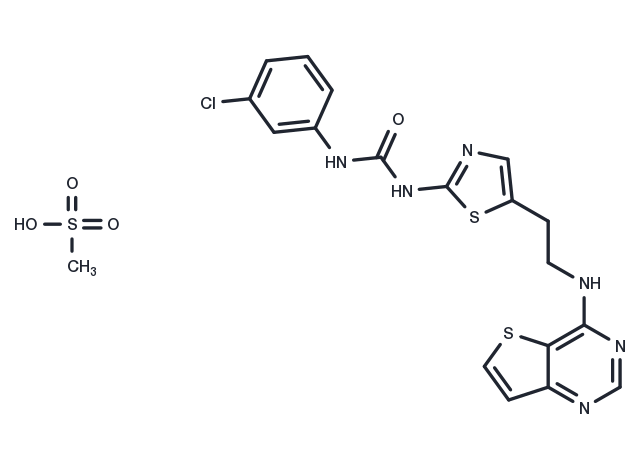Powder: -20°C for 3 years | In solvent: -80°C for 1 year
SNS-314 Mesylate (SNS-314) is an effective and specific Aurora A/B/C inhibitor (IC50: 9/31/3 nM). It is less inhibition of Trk A/B, Fms, Flt4, c-Raf, Axl, and DDR2.

| 説明 | SNS-314 Mesylate (SNS-314) is an effective and specific Aurora A/B/C inhibitor (IC50: 9/31/3 nM). It is less inhibition of Trk A/B, Fms, Flt4, c-Raf, Axl, and DDR2. |
| ターゲット&IC50 | Aurora A:9 nM, Aurora B:31 nM, Aurora C:3 nM |
| In vitro | In HCT116 colon xenograft models, SNS-314 exhibits significant and sustained anticancer effects. Additionally, in xenograft models of human breast cancer, prostate cancer, lung cancer (H1299 and Calu-6), ovarian cancer, and malignant melanoma, SNS-314 (170 mg/kg) demonstrates a tumor growth inhibition rate of 54-91%. |
| In vivo | Continuous treatment with SNS-314 in combination with gemcitabine, carboplatin, doxorubicin, fluorouracil, and SN-38 enhances antiproliferative effects. Synergistic effects are observed when SNS-314 is used together with gemcitabine, docetaxel, or vincristine. SNS-314 exhibits significant inhibitory activity against tumor cell lines (IC50: 1.8-24 nM), independent of the relative protein levels of Aurora-A or Aurora-B. |
| キナーゼ試験 | Aurora-A Kinase Assay: Humanized mouse Aurora A (amino acids 107-403) is expressed in E. coli as described previously. For IC50 assays, compounds are titrated three-fold in DMSO and diluted 12.5-fold into assay buffer (10 mM Tris HCl pH 7.2, 10 mM MgCl2, 0.05% NaN3, 0.01% Tween-20, and 0.1% BSA). Compounds are then diluted 4-fold into assay buffer containing Aurora A and FAM-PKAtide at final concentrations of 2 nM and 50 nM, respectively. The kinase reaction is initiated by adding ATP in assay buffer at a final concentration of 10 mM and incubated at 21 °C for 25 minutes. As a positive control, DMSO is added instead of compound and as a negative control assay buffer is added instead of Aurora A. Both control reactions are conducted in triplicate. To detect phosphorylated PKAtide, the kinase reaction is combined with Progressive Binding Solution (1:400 Progressive Binding Reagent, 1 × Buffer A, Molecular Devices) in a 1:3 ratio. The mixture is incubated for 30 minutes at 21 °C and the plate is scanned on an Analyst AD with excitation at 485 nm and emission at 530 nm. The percent relative enzymatic activity is calculated by normalizing the mP value for each well to the average positive control. Relative enzymatic activity values are plotted as a function of the logarithm of compound concentration and IC50 values are generated in GraphPad Prism software using a sigmoidal dose-response curve-fit. IC50's are calculated as the concentration of compound at which enzymatic activity i |
| 細胞研究 | Viability is measured using the CellTiter-Blue cell viability assay. Cells are treated as described above, although with a 5-day incubation period. Cytotoxicity is determined by measuring intracellular ATP using the CellTiter-Glo Luminescence Cell Viability Assay. Cells are seeded in white 96-well tissue culture plates at a density of 1.5-2 × 103 cells/well, and a serial dilution of SNS-314 is dosed in combination with fixed concentrations of either docetaxel or vincristine for a total of 72 hours. Viability is determined as the ratio between the ATP in treated cells versus control cells. Apoptosis is measured using the caspase-Glo 3/7 system. Cells are plated in white 96-well plates as described above and treated first with SNS-314 for 24 hours, washed with 200 μL of 1× PBS, and fresh medium is added with the second agent for 24 hours.(Only for Reference) |
| 別名 | SNS-314 |
| 分子量 | 527.04 |
| 分子式 | C18H15ClN6OS2·CH4O3S |
| CAS No. | 1146618-41-8 |
Powder: -20°C for 3 years | In solvent: -80°C for 1 year
DMSO: 52.7 mg/mL (100 mM)
You can also refer to dose conversion for different animals. 詳細
bottom
Please see Inhibitor Handling Instructions for more frequently ask questions. Topics include: how to prepare stock solutions, how to store products, and cautions on cell-based assays & animal experiments, etc.
SNS-314 Mesylate 1146618-41-8 Cell Cycle/Checkpoint Chromatin/Epigenetic Aurora Kinase HeLa SNS314 Mesylate H-1299 SNS 314 Mesylate PC-3 ovarian cancer cell A2780 Inhibitor SNS 314 inhibit HT29 SNS314 HCT116 SNS-314 inhibitor
